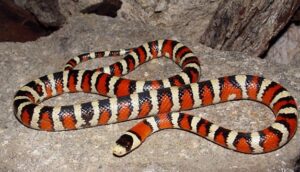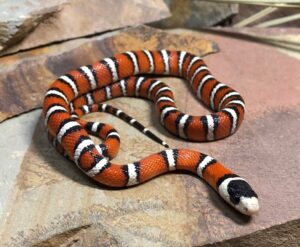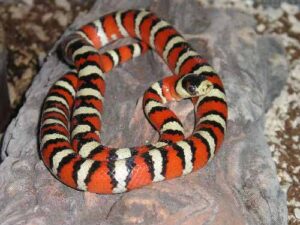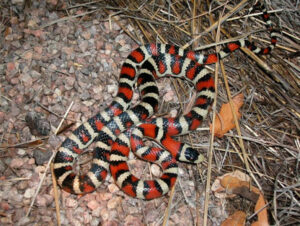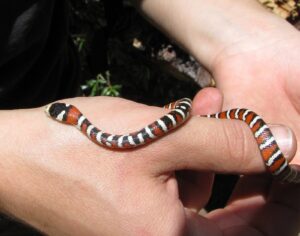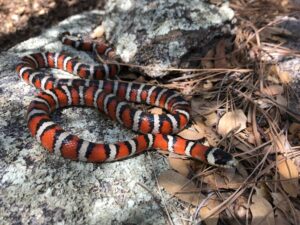Arizona Mountain Kingsnake (Lampropeltis pyromelana)
Updated on
25/04/2024As the name suggests, the Arizona mountain kingsnake is endemic to Arizona. The small snake is also known by the name, Sonoran mountain kingsnake. It is most active during the day.
Scientific Classifications
- Suborder:Serpentes
- Family:Colubridae
- Genus:Lampropeltis
- Species:L. pyromelana
Conservation Status
Description
Size
It can grow up to 36 in (91 cm) in length.
Color and Appearance
The color of the Arizona mountain kingsnake is an instance of mimicry in nature. Their red, black, and white bands can easily be mistaken for the venomous Arizona coral snake’s red, black, and yellow or white bands. The coloration acts as a defensive measure against predators. Closer examination reveals that the red bands of the kingsnake are bordered by black, whereas those of the coral snake are bordered by yellow or white.
Are They Dangerous to Humans
When disturbed, the colubrid emits a powerful and foul-smelling musk. Predators find the smell pretty repulsive and often release the serpent without causing much damage. Though they can bite when picked up, they are completely harmless to humans.
Arizona Mountain Kingsnakes at a Glance
Distribution
Within Arizona, the kingsnake has a discontinuous range that extends from the extreme northwestern corner of the state, across the Mogollon Rim and the central mountain ranges into the ‘sky island’ mountain ranges of the southeast.
Habitat
It can be found at elevations of 3000-9000 ft (910-2740 m) in a wide range of habitats varying from chaparral to conifer forests, often near springs or streams and associated with juniper woodlands.
The Arizona mountain kingsnake spends the daytime among logs, rocks, or dense clumps of vegetation.
Lifespan
They live for 12-20 years.
Predators
Lizards, birds of prey, predatory mammals, and other snakes feed on it.
Diet
The Arizona mountain kingsnake eats rodents, lizards, and nestling birds. They kill their prey by constriction.
Reproduction
Oviparous (lays eggs that hatch outside the body)
They mate after emerging from brumation. Female snakes lay clutches of 3-20 eggs each. The oval-shaped eggs are leathery in texture. The hatchlings measure 9 in (22.86 cm) in length. The young reach sexual maturity at the age of 3-4 years.
Care Sheet
Size of the Enclosure: The pet can be kept in a cage of minimum size, 3ft (length) x 2 ft (breadth) x 2 ft (height).
Temperature: The cool end of the tank should be kept at 60-65°F, and the warm end should be maintained at 80-85°F. There should be a drop of 5-10°F at night.
Humidity: The humidity level should be 40%-60%.
Substrate: Aspen shavings, newspaper, or corn-cob-type rodent bedding are suitable options for the substrate.
Feeding: They can be fed cold-blooded prey like frogs, lizards, and other snakes as well as warm-blooded prey like rodents and birds.
Source
reptilescove.com, morphmarket.com, reptarium.cz, projectnoah.org, reddit.com, ndow.org

